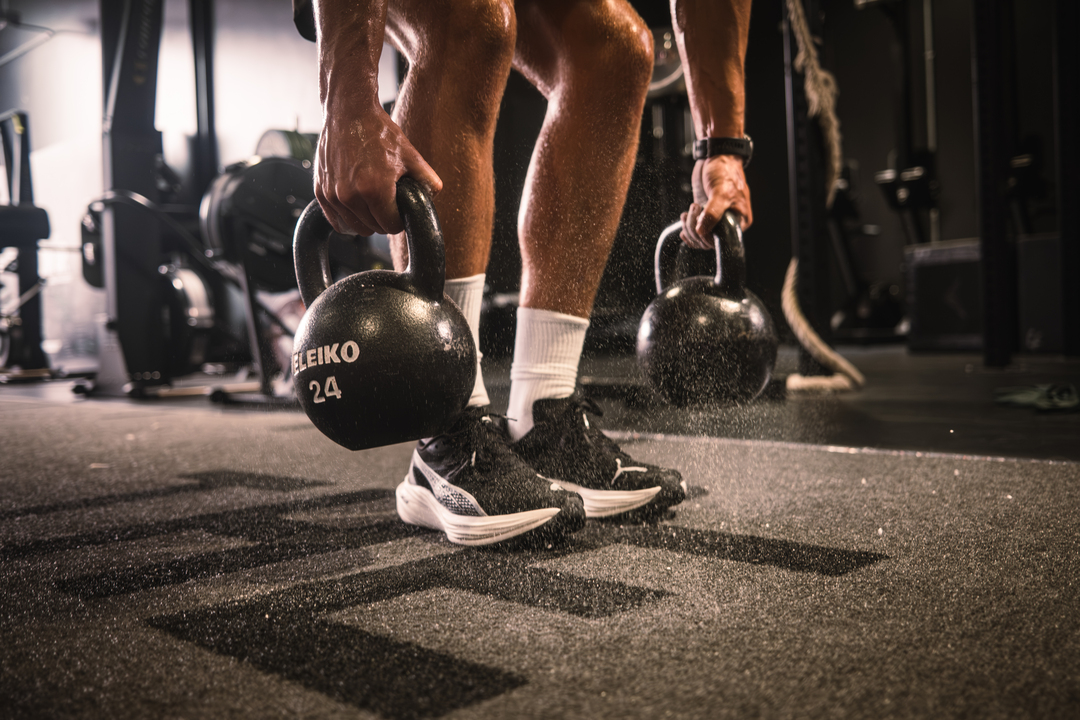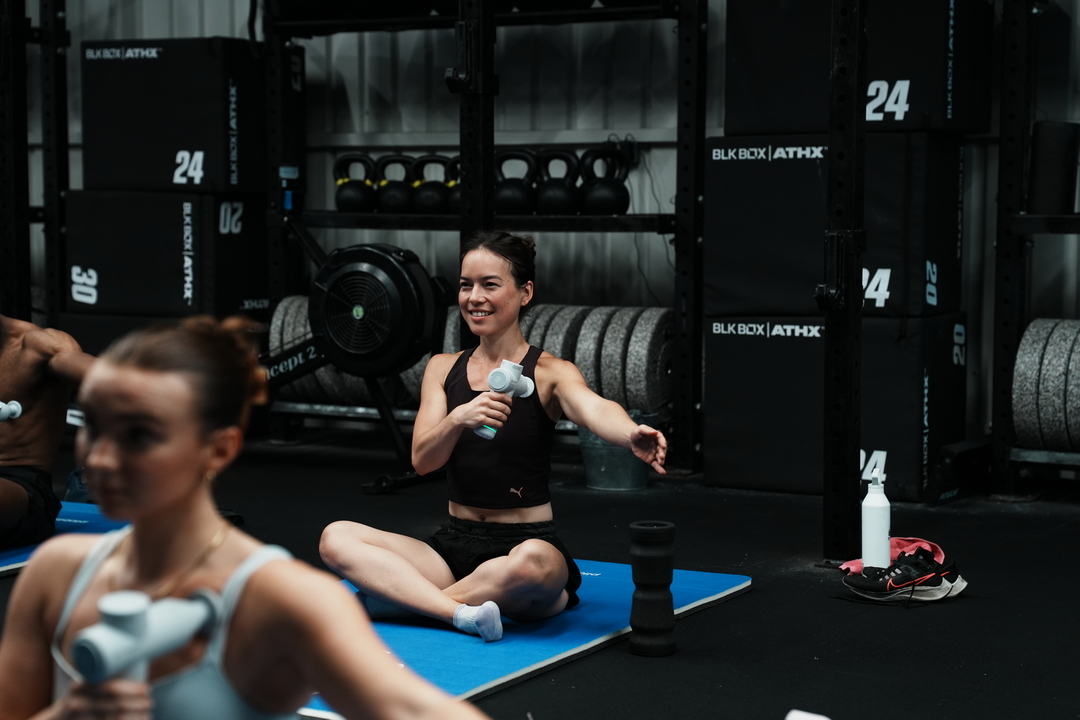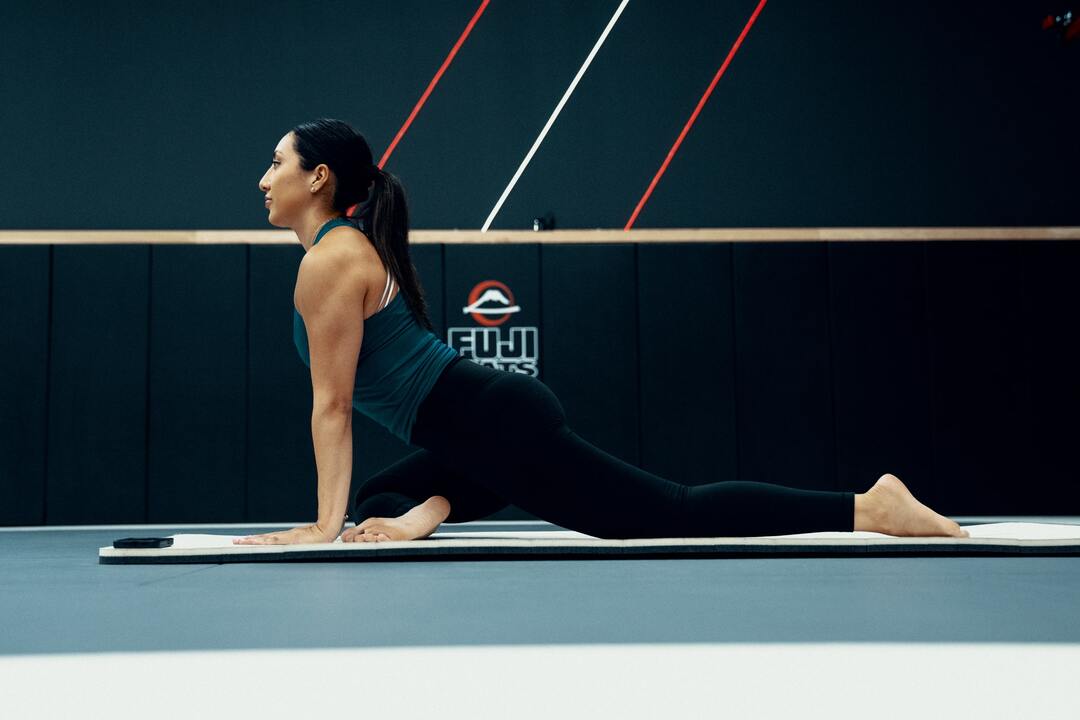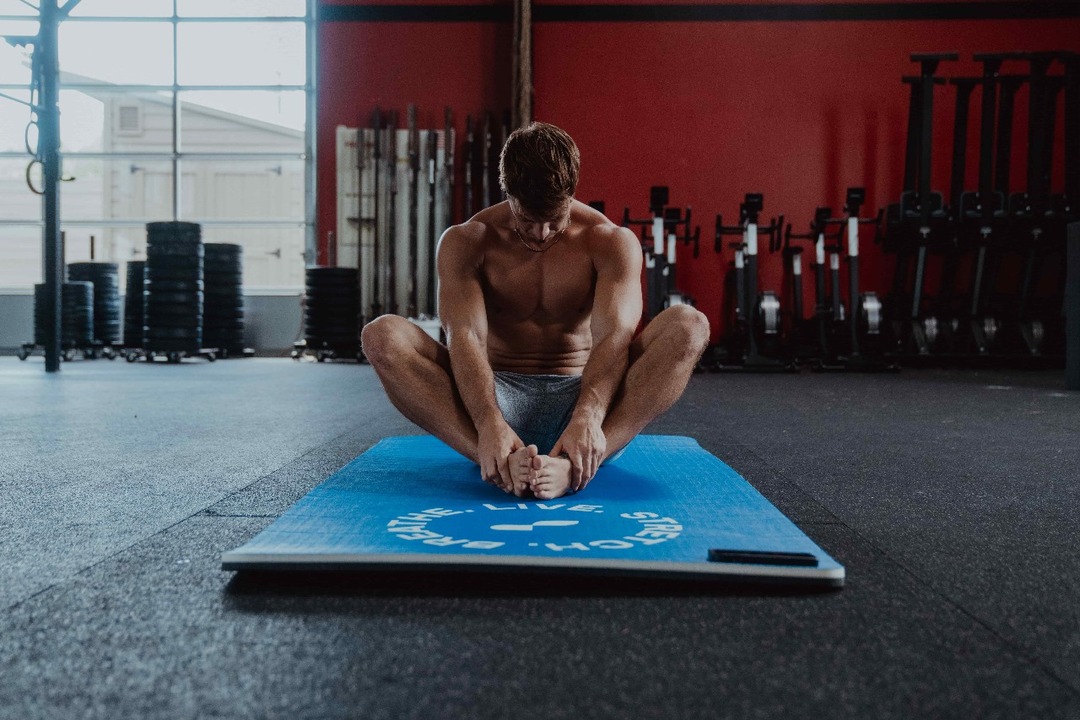You push for a new PR and feel a sharp twinge in your shoulder or a dull ache in your lower back—sudden setbacks that can erase weeks of progress. Injuries in weightlifting are common, from overuse strains and tendonitis to joint pain and ligament sprains, and they sit at the intersection of technique, training load, and recovery. Want to lift longer without getting sidelined? This article explains how to recover quickly from a workout with clear recovery techniques, mobility routines, warm-up and cool-down habits, and rehab-friendly corrective exercises so you can build strength and muscle safely while avoiding painful setbacks or long-term damage.
To make that easier, Pliability's mobility app offers short, guided routines, progress tracking, and simple corrective drills to reduce the risk of strains and shoulder problems while improving flexibility and stability, so you can stay on track with your strength and muscle goals.
Summary
- Poor technique is the primary driver of injury, with research indicating that approximately 70% of weightlifting injuries are due to poor form. Alignment and controlled bar paths determine tissue stress more than load alone.
- Lower back and shoulder issues dominate the injury profile: Over 50% of injuries occur in the lower back due to improper lifting techniques, about 20% of weightlifters experience shoulder injuries, and roughly 30% of shoulder cases are tied to faulty overhead form.
- Acute failures and overuse follow different paths, and strains left unmanaged for 4 to 8 weeks commonly progress to persistent stiffness and reduced load tolerance, often requiring organized rehab across a six-month window.
- Prevention is practical and high value, since around 80% of weightlifting injuries are considered preventable with proper technique, and about 60% can be avoided through targeted warm-up routines, making deliberate form work and ramped warm-ups essential risk management.
- Program decisions matter: conservative progression rules such as adding 2.5 to 5% only when sets finish easily, planned deloads every 3 to 6 weeks with volume reductions of 40% to 60%, and RIR checks limit fatigue-driven technical collapse.
- Small, repeated technical errors compound when teams rely on gut checks, and because roughly 70% of injuries trace back to poor form, objective movement monitoring is critical to spot degrading bar paths before they become weeks or months of recovery.
This is where Pliability's mobility app fits in. The mobility app addresses this by providing short guided routines, progress tracking, and simple corrective drills that reduce the risk of strains and shoulder problems while improving flexibility and stability.
How Poor Weightlifting Form Leads to Injury

Poor technique redirects force away from strong, intended pathways and into small joints, ligaments, and tendon attachments that were never meant to handle it. When alignment breaks, you get concentrated shear and torsion rather than distributed muscular load-bearing, and that is how both sudden tears and slow-burning overuse injuries start.
How Does Bad Alignment Change Where the Load Goes?
Think of the spine and major joints as load-bearing highways. Good form keeps traffic flowing along wide lanes, through large muscles and thick connective tissue. When you round the back on a deadlift, the lumbar spine moves from a stable, neutral position into flexion, which shifts load from the posterior chain into the posterior annulus and ligamentous structures, increasing disc pressure and anterior shear on the vertebrae.
Compromised Bar Path and Injury Risk
The bar path shortens, the hips stop contributing, and the hamstrings and lower back take an outsized share of the work. That mechanical change converts what should be a coordinated hip hinge into a lever that torques individual vertebrae and surrounding ligaments, raising the risk of a herniated disc or acute strain.
Why Does Momentum or “Cheating” Reps Cause More Damage than They Help?
When you use momentum to complete a rep, you remove the controlled eccentric and concentric phases that let muscles absorb and redirect force. The result is higher peak loads on passive tissues, like joint capsules and tendons, because muscles are not managing deceleration. Over time, those repeated high peaks produce microtears and chronic irritation.
This is not abstract: A 2023 study analyzing injury patterns across weight-training sports found that approximately 70% of weightlifting injuries are due to poor form—a reminder that technique, not just load, determines tissue stress.
How Do Specific Mistakes Produce Specific Injuries?
Different faults produce different force profiles. Excessive forward knee travel and poor femoral tracking in squats increase tensile stress on the patellar tendon and contribute to patellar tendonitis. Flared elbows or improperly rotated wrists on overhead work concentrate compressive and shear forces through the glenohumeral joint and rotator cuff tendons, which helps explain why many lifters develop shoulder pain without a single dramatic event.
A curled supinated arm during a heavy deadlift creates a line of pull that can pop a biceps tendon, which is how a technical error becomes an acute surgical problem. Those pathways explain both sudden failures and the slow burn of tendonosis.
What Separates Acute from Overuse Injuries, Mechanically Speaking?
Acute injuries occur when tissue loads exceed its capacity in a single episode, such as an uncontrolled bar drop, a sudden valgus collapse at the knee, or a tendon rupture at an awkward angle. Overuse injuries occur when submaximal but repeated loads exceed the tissue’s capacity to repair itself, usually due to:
- Poor technique
- Insufficient rest
- Progressive overload without adaptation
Research shows that overloading and fatigue are major contributors, which aligns with reports that many incidents trace back to fatigue and technical errors in tandem, not to a single isolated mistake.
What Patterns of Behavior Keep this Cycle Going?
The familiar approach is to mimic what you see, add weight, and push through discomfort because it “worked before,” and that makes sense when you want progress without extra instruction. The hidden cost is that, at scale, those minor deviations compound: microerrors multiplied by frequency equal chronic breakdown.
Objective Feedback for Technical Correction and Injury Prevention
Platforms like Pliability and similar movement-feedback tools provide lifters with objective bar path and load metrics, plus immediate cues on joint angles, helping them correct technique before minor errors become structural damage. Teams find that objective feedback reduces the recurrence of technical mistakes and prevents progressive overload episodes that lead to chronic injury.
How Should You Think About Prevention When Technique Already Feels Ingrained?
Start by treating technique like a maintenance protocol, not a one-time skill. Warm-ups that prime the exact movement pattern, brief submaximal sets focused on tempo and position, and deliberate eccentric control reduce peak tissue stress. Manage load with conservative progression and frequent technical checks, and treat fatigue as a primary risk factor, because tired muscles stop protecting joints.
Addressing Pain and Equipment for Safe Lifting
If the shoulders pop on overheads or the knees burn after a few sets:
- Reduce volume
- Restore scapular and hip dominance with targeted exercises
- Rebuild range under control
Poor equipment and uneven platforms add unpredictable shear to the equation, so check footwear, platform surface, and bar condition before chasing numbers.
Managing Frustration and Using Measurable Checkpoints
Feelings matter here, too. Lifters are often frustrated when told to back off, especially when experience suggests pushing harder produces gains. That frustration is real and rooted in a desire to keep progressing. The pragmatic route is to let intensity return only after technique and load management are demonstrably restored, using measurable checkpoints such as:
- Pain-free range
- Normalized joint tracking in slow reps
- Restored capacity in corrective movements
The Bent Link Analogy: Technique and Structural Integrity
A simple image helps: imagine a chain where one weak link bends slightly every time it is loaded; eventually, the chain fails at that spot. Technique faults are the bent links. Fix the link, and the chain carries far more weight safely.
That solution-oriented approach sounds practical, but it is not the end of the story; the next part uncovers which specific injuries result from these mechanical failures and why some of them remain hidden until it is almost too late.
Related Reading
- Why is a Recovery Period Between Bouts of Exercise Important?
- Signs of Injury
- Hip and Knee Pain
- Why Do the Insides of My Legs Hurt When I Run
- Deadlift Back Pain
- Signs of Overtraining Cycling
- Deloading Week
- How Do You Know if You Tore Your ACL
- How to Prevent MCL Injuries
8 Common Injuries in Weightlifting

Weightlifters most often face eight predictable injuries, each with its own tissue, typical trigger, and a set of warning signs you can act on early to avoid long recoveries. Below, I list each injury, what usually causes it, the exact area involved, common symptoms, and practical red flags or rehab notes you can use immediately.
1. Back Strain: What Happens in the Lower Back and How It Starts?
Lower back muscle strain typically affects the lumbar paraspinals and erector spinae muscles, sometimes involving local fascia. It usually shows up after sudden overload, repetitive heavy sets without recovery, or lifting with a fatigued posterior chain. You will feel a sharp or dull ache in the lower back, worse with bending or standing, sometimes accompanied by muscle tightness and spasms.
Persistent radiating pain, numbness, or bowel or bladder changes are red flags that need urgent assessment. Recovery ranges from days for a mild strain to 6-12 weeks for more severe muscular tears, and early management is activity modification, targeted mobility work, and progressive posterior chain loading.
2. Shoulder Impingement: Why the Shoulder Starts to Ache with Overhead Work?
Impingement irritates the rotator cuff tendons and subacromial bursa under the acromion, creating pain when the arm is raised. It often follows repetitive overhead reps, poor scapular rhythm, or inadequate rotator cuff conditioning. Expect pain with elevation above 60 degrees:
- A painful arc
- Night pain
- Trouble sleeping on the affected side
Shoulder Injury Prevention and Rehab: Form and Control
Note that a 2023 review found that 30% of shoulder injuries in weightlifting are attributed to incorrect form during overhead lifts, underscoring the importance of mobility and controlled volume in prevention. Conservative rehab focuses on scapular control, eccentric cuff work, and progressive return to overloaded overhead patterns.
3. Rotator Cuff Tear: How to Tell a Tear from a Stubborn Strain?
Rotator cuff tears involve partial or full-thickness disruption of tendons such as the supraspinatus or infraspinatus. Chronic degeneration from repetitive loading or an acute overload during a heavy snatch or press can cause it. Symptoms include:
- Sharp pain
- Weakness, particularly with external rotation or abduction
- A decreased ability to lift or control weight overhead
Small tears may respond to progressive strengthening over 8–12 weeks; larger tears that produce persistent loss of function or night pain often need surgical referral. A practical rule is that when weakness persists despite a guided rehab plan for six weeks, escalate evaluation.
4. Biceps Strain and Tendon Rupture: What the Arm Tells You?
Biceps strains affect the muscle belly or tendon, often from heavy curls, mixed-grip deadlifts with sudden load increases, or repetitive eccentrics. If the tendon retracts, an acute proximal long head rupture usually produces:
- Sudden pop
- Immediate pain
- Bruising on the arm
- “Popeye” bulge
Symptoms and Initial Treatment
Symptoms include focal anterior arm pain, weakness in elbow flexion and supination, and visible swelling or deformity. Early treatment is RICE and referral to a specialist when function is significantly impaired; partial strains recover with progressive loading and technique correction.
5. Patellar Tendonitis: Why Your Knees Burn Under Load?
Patellar tendonitis involves inflammation of the patellar tendon at its attachment below the kneecap, a common problem among athletes who perform high-volume squatting or jumping without balanced quadriceps-hamstring control. You will feel localized pain below the patella that worsens with the first few reps, stair descent, or prolonged sitting after activity.
Eccentric decline squats and slow progressive loading are evidence-based rehab tools; ignoring the signal and chasing volume usually prolongs recovery.
6. Knee Ligament and Meniscal Injuries: How to Read Instability or Locking?
Knee injuries vary from ligament sprains to ACL ruptures or meniscal tears. They typically arise from sudden valgus collapse, rotational forces under load, or unexpected foot placement during heavy squats and dynamic lifts. Symptoms include:
- Immediate swelling
- A popping sensation at the time of injury
- Instability (giving way)
- Catching
- Mechanical locking
Acute instability or inability to bear weight requires prompt imaging and orthopedic assessment; many partial tears can be managed with targeted strengthening and neuromuscular training, but structural instability often needs surgery.
7. SLAP Tear: What Labral Damage Feels Like in the Shoulder?
A SLAP lesion is a tear of the superior labrum where the biceps tendon attaches, common in lifters who repeatedly load the arm overhead or sustain a fall on an outstretched hand. Expect deep joint pain, clicking, catching, and weakness with overhead loads, as well as discomfort with resisted biceps contraction.
These injuries can be subtle, often mimicking rotator cuff pain; if performance stalls despite focused rehab, diagnostic imaging and specialist assessment can clarify whether repair is necessary.
8. AC Joint Arthritis and Distal Clavicle Osteolysis: Why the Top of the Shoulder Hurts After Pressing?
Distal clavicle osteolysis, commonly called weightlifter’s shoulder, damages the acromioclavicular joint from repetitive axial loading and microtrauma. Symptoms include:
- Dull ache at the AC joint
- Tenderness to direct pressure
- Pain with cross-body adduction
- Swelling at the tip of the collarbone
Activity modification, temporary load reduction on bench and press variations, and localized rehab that improves scapular mechanics usually resolve symptoms; persistent bone changes may show on X-ray and require specialist input.
Objective Tracking for Chronic Pain Prevention and Program Consistency
Most lifters train the same way because it is familiar and produces gains. That approach works until slight, repeated stresses fragment recovery and create chronic pain that limits loading and progression. Platforms like Pliability provide objective movement tracking, load history, and automated technical cues, so lifters spot accumulating risk before pain becomes structural, reducing time lost to injury and restoring measurable consistency to programming.
This pattern appears across both weekend competitors and coaches building programs: lower body complaints stack up, recovery feels insufficient, and lifters report rarely being at 100% between sessions, which is why early recognition matters so much.
Curiosity loop: You think these descriptions close the book on prevention, but what actually happens next is harder — and more consequential — than most imagine.
Related Reading
- How to Prevent Peroneal Tendonitis
- Why Do My Knees Hurt After Squats
- How to Prevent Arthritis in Hands
- How to Prevent Achilles Tear
- Ankle Sprain Prevention
- How to Prevent Knee Injuries
- Shoulder Impingement Exercises to Avoid
- Ankle Mobility for Runners
- How to Avoid Rotator Cuff Injury
What Are the Risks of Weightlifting Injuries?

Injuries in weightlifting create immediate disruption and can lead to long-term decline, from short bouts of pain and swelling to persistent mobility loss and chronic pain that limits life beyond the gym. Left unaddressed, minor strains change movement patterns, pile up as compensations and muscle imbalance, and eventually force surgical interventions or a permanent drop in performance.
What Happens Right After an Injury?
You feel pain, you swell, and your motion becomes limited —those three signals are your body asking for a different strategy. Acute pain and inflammation protect tissue but also shut down standard motor control, which is why a sore area often becomes guarded. The surrounding muscles stop firing normally within days.
That early protective pattern shortens ranges, substitutes weaker muscles for stronger ones, and makes simple tasks feel stiffer and slower.
How Do Minor Strains Turn into Chronic Problems?
This is a predictable cascade: an untreated strain heals with scar tissue and altered neuromuscular timing, shifting load to other structures and creating repetitive microtrauma. After working with lifters over a six-month rehab window, the pattern became clear: strains left unmanaged for 4 to 8 weeks commonly progressed to persistent stiffness and reduced load tolerance by the time they returned to complete training.
Central sensitization also appears in some athletes, meaning pain signals become amplified even after the tissue has partly healed, which explains why harmless positions still trigger significant discomfort.
Most people handle this by pushing through soreness because continuity matters, and that approach seems sensible until the pileup becomes chronic dysfunction. But going through without objective feedback lets small deficits compound across sessions, pain-free reps get rarer, and recovery windows shrink.
Proactive Risk Detection and Injury Mitigation
Platforms like Pliability provide continuous movement tracking, load history, and automated technical cues, giving teams objective signals that reveal accumulating risk before symptoms become structural and recovery stretches from weeks into months.
How Do Severe Injuries Change Life Beyond Performance?
When a tendon tears, a joint destabilizes, or degeneration takes hold, you may face prolonged rehab, surgery, and permanent changes to mobility and function.
A 2024 systematic review explains that over 50% of injuries occur in the lower back due to incorrect lifting techniques, illustrating why lumbar problems often demand extended care and, in some cases, surgical referral—because the back bears concentrated forces when form falters.
The Life-Altering Impact of Form-Related Shoulder Injuries
The same review also notes that 20% of weightlifters experience shoulder injuries from improper form, which is why chronic shoulder pain so frequently undermines overhead capacity and daily comfort. Those structural failures are not just training setbacks; they alter how you move, how you sleep, and how you plan your life.
Why Does Injury Wreck Motivation and Training Momentum?
Frustration and loss of momentum follow fast, especially when gains evaporate during forced rest. After a month off, athletes commonly report feeling disconnected from their progress and anxious about reinjury; that fear changes behavior, leading to guarded lifts and reduced intensity that further slows recovery.
Practically, muscle atrophy and neuromuscular deconditioning lower tolerance for volume, and compensations that develop while you’re healing increase the risk of new injuries when you return.
What Does This Mean for How You Should Treat Early Pain Signals?
Treat early pain as a warning, not an obstacle to grit. Small changes in programming, objective checks on movement, and timely intervention preserve both tissue and motivation. When lifters learn to respect warning signs and use tools that quantify technique and load, they recover faster and avoid the psychological spiral of repeated setbacks.
This sounds decisive, but the next question is more complex and more revealing than you expect.
What Can You Do to Prevent Weightlifting Injuries?
You avoid most weightlifting injuries by treating prevention like training: set clear lift rules, practice control under light load, and schedule recovery as deliberately as your working sets. Below are specific, hands-on steps you can put into practice today that build on Dr. Braunreiter’s five tips and move you from intention to habit.
Check Your Ego at the Door
Set hard boundaries before you walk up to the bar. Pick a session ceiling you will not exceed, use a partner to veto any ad hoc jumps in weight, and adopt a 60-second cooling rule before attempting a new personal best. These small rituals remove the social pressure that makes a safe program crumble into reckless loading.
Master Your Form First
Break complex lifts into components and rehearse them at slow tempos, then stitch them back together. Use video from two angles, and assign a simple checklist for each rep:
- Bar path
- Hip drive
- Chest position
- Knee tracking
After coaching lifters through eight-week technical blocks, the pattern was clear: technique errors correct rapidly when practice focuses on positions and tempo rather than load.
Technique matters so much that correcting it should be a central training objective, aligning with findings that 80% of weightlifting injuries are preventable with proper technique, making deliberate form work a high-return, low-risk investment.
Increase Load Slowly
Use repeatable rules for progression: add 2.5% to 5% when you finish all sets with an easy last rep, or follow an RIR check—only increase the weight when you clearly have at least one rep left in reserve. Track sets, loads, and perceived effort in a simple log so you can spot trends, not myths. Program a planned microcycle that alternates heavier and lighter sessions each week to protect connective tissue and preserve long-term volume.
Add in Intentional Variety
Rotate movement patterns across mesocycles to redistribute stress, for example, pairing heavy squats with single-leg stability work and anti-rotation core drills in the next block. Include mobility and low-impact aerobic days to improve tissue quality and recovery capacity without stealing training specificity. This is not fluff; it is resilience by design.
Include Rest and Deloads
Schedule a deload week every 3 to 6 weeks, depending on volume and life stressors, dropping volume by 40% to 60% while maintaining intensity to preserve motor patterns. After working with competitive lifters across multiple 12-week cycles, a consistent deload strategy maintained training availability and reduced cumulative soreness, enabling athletes to resume progress with less friction.
Warm Up with Purpose
Replace arbitrary jogging with movement-specific ramps: start with joint prep, then two to three ramp sets at progressively higher intensities before working weight, finishing with one or two sets that match the movement tempo of your working sets. That practical warm-up habit protects tissues and prepares neural drive, underscoring findings that 60% of weightlifting injuries can be prevented with proper warm-up routines, showing that warm-ups are more than ritual; they are risk management.
Hydration, Nutrition, and Sleep You Can Act On
Aim for consistent nightly sleep windows, prioritize a protein-containing meal or supplement within 60 to 90 minutes after hard sessions, and sip fluids throughout the workout rather than waiting until you feel thirsty. These three levers move recovery capacity quickly; when athletes improve sleep timing and post-workout protein, next-session readiness and force output follow.
Keep Safety Checks Routine
Before every session, conduct a two-minute equipment and environment check: inspect bands for fray, confirm collars are locked, verify the bar and platform are secure, and lock eyes with a spotter for heavy reps. Small safety rituals prevent significant, avoidable mistakes.
The Pitfalls of Relying on Gut and Habit
Most teams handle technique checks and load decisions by gut and habit, because that approach is familiar and requires no extra tools. As training volume and complexity grow, that habit hides accumulating faults:
- Feedback gaps
- Missed deviations
- Delayed interventions that lengthen recovery and stall progress
Solutions like Pliability provide continuous movement tracking, objective load history, and automated technical cues, letting teams spot degrading bar paths and rising fatigue without endless video review, compressing manual error-finding into immediate, actionable signals.
Training Consistency and Smart Habits as Injury Insurance
Train these practices like a skill: rehearse them, measure them, and make them nonnegotiable parts of a session. Consistency and smart training habits are the single best insurance policy for long-term strength and injury prevention. There’s one recovery tool that most lifters underestimate, and what it does next will change how you plan every session.
Improve Your Flexibility with Our Mobility App Today | Get 7 Days for Free on Any Platform

I know it’s maddening when mobility work gets shortchanged and you end up training through stiffness and feeling isolated from valuable feedback. Consider Pliability, a mobility app that integrates into your routine with daily custom programs and body scanning. Try the seven-day free trial and see why 80% of users reported improved flexibility within four weeks, and 90% of users recommend the app to friends.
Related Reading
- Glute Activation Exercises
- Eccentric Quadriceps Exercises
- How to Squat Without Knee Pain
- Injury Prevention for Runners
- How to Start Working Out Again After Knee Injury
- Signs of Overtraining Running
- Scapular Mobility Exercises
- SI Joint Mobility Exercises
- Running Injury Prevention Exercises








